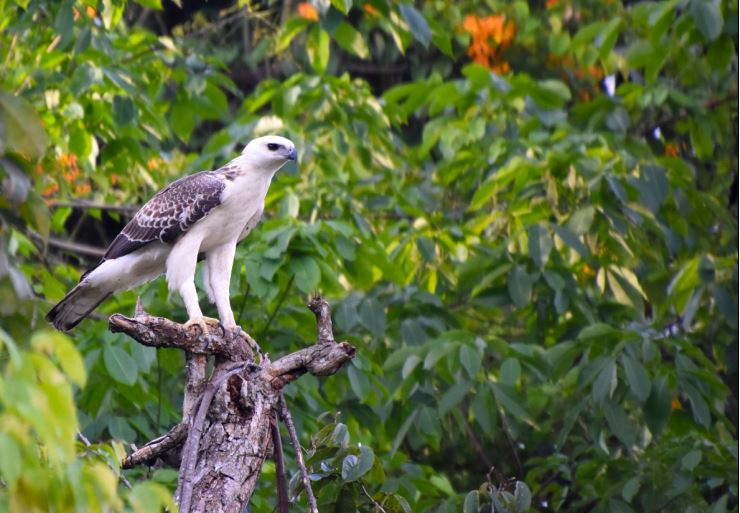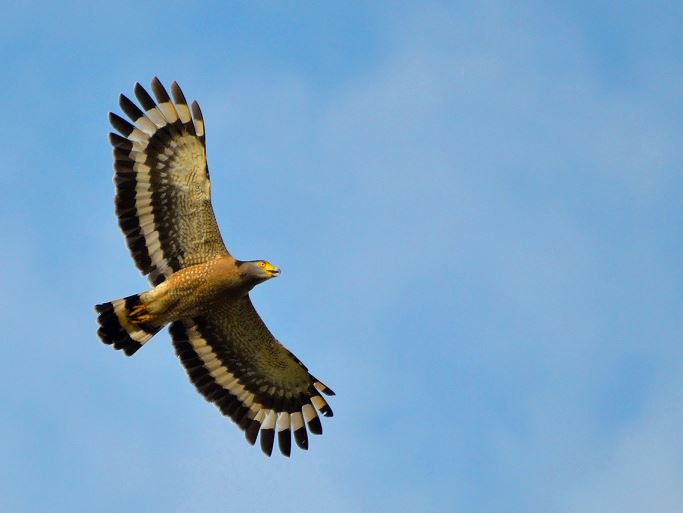November 08, 2024
Eagles and falcons have made themselves at home in virtually every terrestrial habitat on the planet, and are just as commonplace in popular culture. Synonymous with strength, bravery and the untamed wildness of our world, they are often chosen as a national symbol by countries looking to embody these traits (Indonesia and the USA being just two examples among many).
At Restorasi Ekosistem Riau (RER), studying these animals in detail has revealed some truly fascinating facts. For example, did you know eagles mate for life? Or that falcons are more closely related to parrots than eagles? If you’re hungry for more, this article provides six tasty morsels about these amazing apex predators.
1. A parrot crossed with a jet fighter
Let’s start with the science. Although eagles and falcons look similar, they’re not actually that closely related at all. This is in fact a recent discovery – up until 2008, both groups were classed in the same order of predatory birds called Falconiformes. However, through DNA and phylogenetic analysis, it was discovered they diverged just after the age of the dinosaurs, approximately 57 million years ago.
So where does that leave eagles and falcons in the family tree of raptors today? Well, falcon species like kestrels, hobbys, and caracaras are still classed as Falconiformes, whereas eagles, hawks, kites, and buzzards now have their own order, called Accipitriformes. It also means that falcons are more closely related to parrots than their distant eagle cousins.
2. Teeth, talons and …trousers?
You don’t need to see these animals’ DNA to spot the difference between them. For starters, eagles tend to be a lot bigger than falcons. The martial eagle (Polemaetus bellicosus) has a wingspan of 8.5 feet, whereas even the biggest falcon – the gyrafalcon (Falco rusticolus) – is only about half that size.
For another clear difference in the physical characteristics of an eagle and a falcon, let’s take a look at the beak. All falcons have something called ‘tomial teeth’ – basically, their top mandible curves down into a long, sharp point. This razor-sharp dagger is used to quickly and efficiently finish off their prey. Eagles, on the other hand, tend to kill their prey using their talons instead of their beaks, which have a comparatively smoother and more sturdy-looking upper mandible.
Another unique and fascinating feature of eagles is their trousers – that’s right, in all ‘true eagle’ species, the lower leg (known as the tarsi) is feathered all the way down to the foot. That’s the reason this group are sometimes referred to as ‘booted eagles’.
3. From rainforests to the urban jungle
Eagles have made their home in a wide range of habitats and nearly all parts of the world. They soar over northern tundra, circle arid deserts and lurk in equatorial rainforests. Falcons are similarly widespread, having colonised every continent – including Antarctica. The striated caracaras (Phalcoboenus australis) falcon is the southernmost breeding bird of prey, and one of the world’s rarest raptors. The world’s most widespread bird of prey – the Peregrine falcon (Falco peregrinus) – can be found everywhere from sea level to high rocky mountains, and from freezing polar regions to the hothouse of the tropics – they even nest on the skyscrapers of Manhattan!
4. Takeaways and in-flight meals
Remember the differences between beaks on falcons and eagles? These divergent physical traits also hint at different hunting behaviours. We already know that eagles kill with their talons, while falcons do the job with their beak – another fascinating fact is that falcons more commonly capture their prey on the wing, either ‘stooping’ down in freefall from a great height, or simply outpacing their quarry in a horizontal chase. When diving, the peregrine has been clocked at an incredible 242 mph (390 km/h), making it the fastest animal on earth.

As if these dazzling aerobatics weren’t impressive enough, falcons also eat what they catch mid-flight, allowing them to continue hunting without rest. A falcon’s diet includes a wide array of shorebirds, ducks, grebes, gulls, pigeons, and songbirds. Hares, mice, lizards and insects can also fall prey to these jet-heeled hunters.
Being bigger and heavier means an eagle must take a different, but no less effective, approach to hunting. Their diet includes large freshwater fish, along with waterfowl, mammals and occasionally even a turtle or two. In tropical regions, some eagle species are known to take monkeys from the treetops.
Like all birds of prey, eagles have extraordinary eyesight, and tend to perch above a river or lake, waiting for the right moment to strike. They then swoop down and plunge those mighty talons into the water to grab their prey, before carrying it back to the nest to eat.
5. The eagle has landed: A love story
Eagles mate for life. Males and females have a courtship ritual that involves soaring to high altitudes, locking talons and then tumbling towards the earth in a tight embrace. They do this to determine the fitness and suitability of a potential mate. They will mate throughout the year, but usually only lay one clutch of 1-3 eggs (four or more is very uncommon).
Eagle fledglings leave the nest at around 18 weeks of age, and reach sexual maturity in their fourth or fifth year. Adults can live for 20 or 30 years in the wild, and some distinguished individuals have even made it to 50!
Falcons also mate for life, but if one of them dies then the survivor will find a new partner almost immediately. Falcons typically raise one clutch each year, but can sometimes stretch to two if something happens to the first. Falcons generally live about 10 years – one of the oldest known peregrines lived to be 19 years old.
6. Call the peregrine pest control
As apex predators, eagles and falcons help control the populations of their prey species, preventing overpopulation that could lead to ecological imbalances. Particularly in extremely biodiverse tropical regions, they prevent any one species from becoming dominant.

Even in urban environments, falcons are known to help control the population of pests like pigeons. By selecting weak, old or slow animals, they also play a key role in natural selection, driving the process of evolution and ultimately ensuring the fittest animals survive.
Conservation efforts in RER
RER is home to nine species of eagles and three species of falcons (listed in table 1 below). As apex predators, their success provides a clear indication of ecosystem health – a sign the food chain is in good working order. In return, these incredible animals continually provide us with fascinating insights into their ecology, biology and behaviour. At RER, studying eagles and falcons helps us better understand their habits, their requirements and their role in the ecosystem; ultimately, this enables us to devise more effective strategies for their conservation.